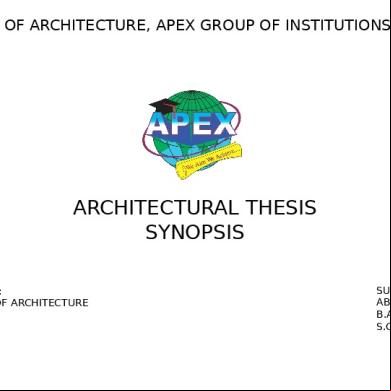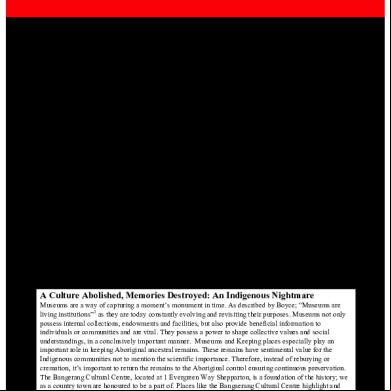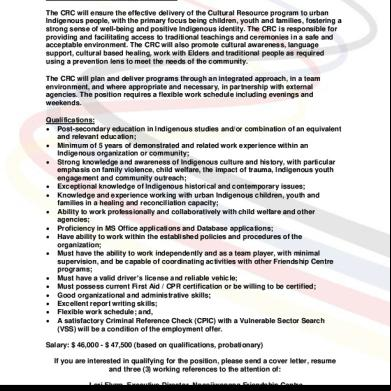Cultural Centre Definition.docx 6l4d
This document was ed by and they confirmed that they have the permission to share it. If you are author or own the copyright of this book, please report to us by using this report form. Report 2z6p3t
Overview 5o1f4z
& View Cultural Centre Definition.docx as PDF for free.
More details 6z3438
- Words: 798
- Pages: 3
History Of the area of Muziris: -Muziris (in Greco-Roman sources, Muciri in Tamil and Muyirikkottu in Malayalam) was an ancient seaport and urban center in south-western India (in Kerala) that dates from at least the 1st century BC, if not before it. Muziris has found mention in the bardic Sangam literature and a number of classical European historical sources. -Muziris holds the key to a good chunk of Kerala’s ancient history. Many artifacts of interest have been unearthed at various sites in North ParurKodungallore region of Kerala, through excavations as part of the Muziris Heritage Project. -Utensils, clothes, coins, agricultural tools and inscriptions on plates or papyrus, along with folklore, tell us about the lives of the people of that time. -The port was a key to the trade between southern India and the Phoenicians, the Egyptians, the Greeks and the Roman Empire. -The important known commodities exported from Muziris were spices (such as black pepper and malabathron), semi-precious stones (such as beryl), pearls, diamonds, sapphires, ivory, Chinese silk, Gangetic spikenard and tortoise shells. -The Romans brought money (in gold coins), peridots, thin clothing, figured linens, multicoloured textiles, sulfide of antimony, copper, tin, lead, coral, raw glass, wine, realgar and orpiment. Location of coin hoards unearthed suggest an inland trade link from Muziris via the Palghat Gap and along the Kaveri Valley to the east coast of India. -Though the Roman trade declined from the 5th century AD, the former Muziris attracted the attention of other nationalities, particularly the Chinese and the Arabs, presumably till the devastating floods of Periyar in the 14th century.
Discoveries from Pattanam: Archaeological research has shown that Pattanam was a port frequented by Romans and it has a long history of habitation dating back to 10th century BC. Its trade links with Rome peaked between 1st century BC and 4th century AD.
A large quantity of artefacts represents the maritime s of the site with Mediterranean, Red Sea and Indian Ocean rims. The major finds include ceramics, lapidary-related objects, metal objects, coins, architectural ruins, geological, zoological and botanical remains.
-Mediterranean: (100 BCE to CE 400) Amphora, terra sigillata sherds, Roman glass fragments and gaming counters.
-West Asian, South Arabian & Mesopotamian: (300 BCE - CE1000 ) Turquoise glazed pottery, torpedo jar fragments and frankincense crumbs. -Chinese: (CE 1600 – CE 1900) Blue on white porcelain sherds. -Regional/Local: (1000 BCE to CE 2000) Black and red ware sherds, Indian rouletted ware, gemstones, glass beads, semi-precious stone beads/inlays/intaglio, cameo–blanks, coins, spices, pottery and terracotta objects. -Urban life: (100 BCE to CE 400) burnt bricks, rooftiles, ring-wells, storage jars, toilet features, lamps, coins, stylus, personal adornment items and scripts on pottery. -Industrial character: (100 BCE to CE 400) Metallurgy reflected in iron, copper, gold and lead objects, crucibles, slag, furnace installations, lapidary remains of semi-precious stones and spindle whorls indicating weaving. -Maritime features: (100 BCE to CE 400) Wharf, warehouse, canoe, bollards. The major discoveries from Pattanam include thousands of beads (made of semi-precious stone), sherds of Roman amphora, Chera-era coins made of copper alloys and lead, fragments of Roman glass pillar bowls, terra sigillata, remains of a long wooden boat and associated bollards made of teak and a wharf made of fired brick.
The most remarkable find at Pattanam excavations in 2007 was a brick structural wharf complex, with nine bollards to harbour boats and in the midst of this, a highly decayed canoe, all perfectly mummified in mud. The canoe (6 meters long) was made of Artocarpus hirsutus, a tree common in Malabar Coast, out of which boats are made off. The bollards some of which are still in satisfactory condition was made of teak.
Three Tamil-Brahmi scripts were also found in the Pattanam excavations. The last Tamil-Brahmi script (dated to c. 2nd century AD, probably reading "a-ma-na", meaning "a Jaina" in Tamil) was found on a pot-rim at Pattanam. If the rendering and the meaning is not mistaken, it establishes that Jainism was prevalent on the Malabar Coast at least from the 2nd century. This is for the first time the excavators are getting direct evidence relating to a religious system in ancient Kerala.
Definition of the proposed cultural centre: This is a Centre for learning as well as performing of Performance arts which are relevant to Kodungallur. The courses offered in different classical and folk art subjects will focus on students belonging to the age group of 13 years till PG level of study.
Other facilities includes a canteen which caters traditional Kerala food to the public and the students,and museums portraying the history of each cultural form dealed with in the cultural centre. -Lobby -Exhibition Gallery and Storage -Multi-purpose Education Room -Cafe and Catering Kitchen - Shop -Loading and Holding
-Public Viewing Deck -Exhibition Galleries -Preparation and Storage -Conference Room -istration
Discoveries from Pattanam: Archaeological research has shown that Pattanam was a port frequented by Romans and it has a long history of habitation dating back to 10th century BC. Its trade links with Rome peaked between 1st century BC and 4th century AD.
A large quantity of artefacts represents the maritime s of the site with Mediterranean, Red Sea and Indian Ocean rims. The major finds include ceramics, lapidary-related objects, metal objects, coins, architectural ruins, geological, zoological and botanical remains.
-Mediterranean: (100 BCE to CE 400) Amphora, terra sigillata sherds, Roman glass fragments and gaming counters.
-West Asian, South Arabian & Mesopotamian: (300 BCE - CE1000 ) Turquoise glazed pottery, torpedo jar fragments and frankincense crumbs. -Chinese: (CE 1600 – CE 1900) Blue on white porcelain sherds. -Regional/Local: (1000 BCE to CE 2000) Black and red ware sherds, Indian rouletted ware, gemstones, glass beads, semi-precious stone beads/inlays/intaglio, cameo–blanks, coins, spices, pottery and terracotta objects. -Urban life: (100 BCE to CE 400) burnt bricks, rooftiles, ring-wells, storage jars, toilet features, lamps, coins, stylus, personal adornment items and scripts on pottery. -Industrial character: (100 BCE to CE 400) Metallurgy reflected in iron, copper, gold and lead objects, crucibles, slag, furnace installations, lapidary remains of semi-precious stones and spindle whorls indicating weaving. -Maritime features: (100 BCE to CE 400) Wharf, warehouse, canoe, bollards. The major discoveries from Pattanam include thousands of beads (made of semi-precious stone), sherds of Roman amphora, Chera-era coins made of copper alloys and lead, fragments of Roman glass pillar bowls, terra sigillata, remains of a long wooden boat and associated bollards made of teak and a wharf made of fired brick.
The most remarkable find at Pattanam excavations in 2007 was a brick structural wharf complex, with nine bollards to harbour boats and in the midst of this, a highly decayed canoe, all perfectly mummified in mud. The canoe (6 meters long) was made of Artocarpus hirsutus, a tree common in Malabar Coast, out of which boats are made off. The bollards some of which are still in satisfactory condition was made of teak.
Three Tamil-Brahmi scripts were also found in the Pattanam excavations. The last Tamil-Brahmi script (dated to c. 2nd century AD, probably reading "a-ma-na", meaning "a Jaina" in Tamil) was found on a pot-rim at Pattanam. If the rendering and the meaning is not mistaken, it establishes that Jainism was prevalent on the Malabar Coast at least from the 2nd century. This is for the first time the excavators are getting direct evidence relating to a religious system in ancient Kerala.
Definition of the proposed cultural centre: This is a Centre for learning as well as performing of Performance arts which are relevant to Kodungallur. The courses offered in different classical and folk art subjects will focus on students belonging to the age group of 13 years till PG level of study.
Other facilities includes a canteen which caters traditional Kerala food to the public and the students,and museums portraying the history of each cultural form dealed with in the cultural centre. -Lobby -Exhibition Gallery and Storage -Multi-purpose Education Room -Cafe and Catering Kitchen - Shop -Loading and Holding
-Public Viewing Deck -Exhibition Galleries -Preparation and Storage -Conference Room -istration





